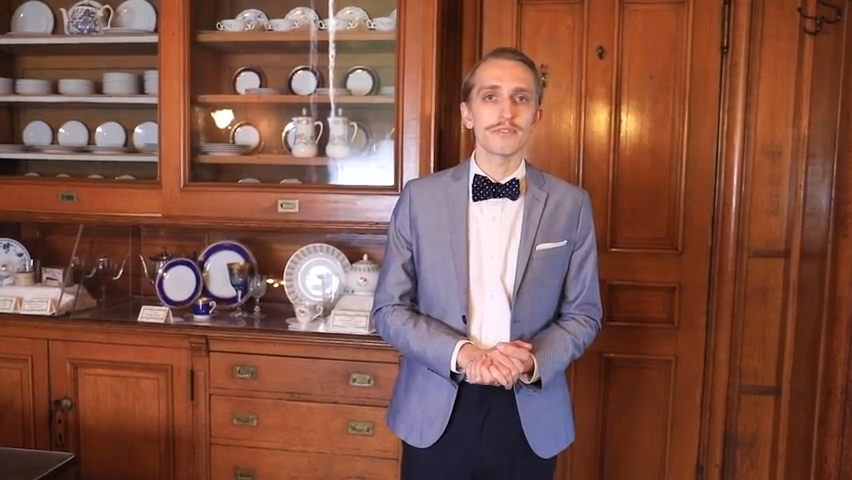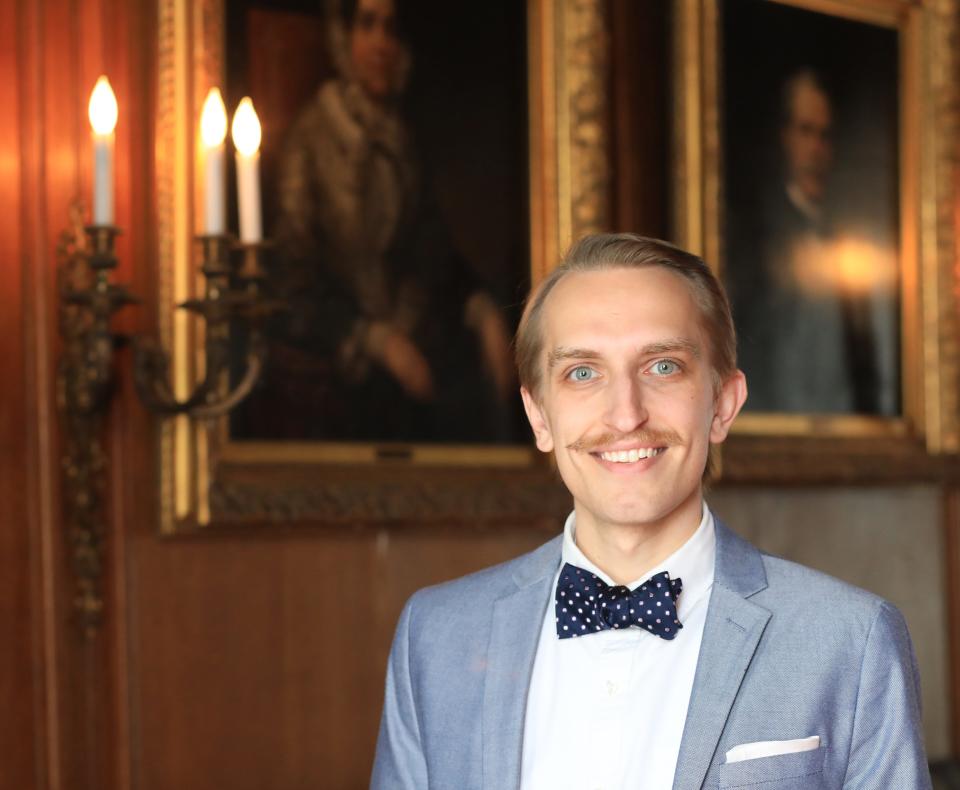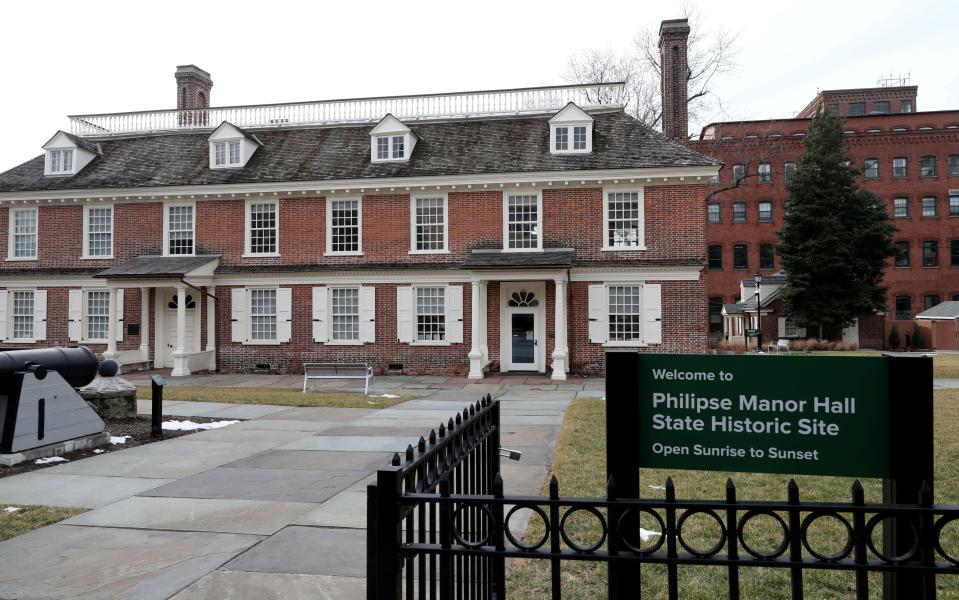Historic sites are reckoning with New York's slave-owning past. Here's how
- Oops!Something went wrong.Please try again later.
When New York's third governor, Morgan Lewis, would return to his estate in Hyde Park in the early 1800s after a tough week in Albany, he’d be greeted by his Black enslaved valet, Stephen, who would carry Lewis' bags up to his brick mansion called Staatsburgh along the Hudson River.
Supper would be prepared on the wood stove by Mary, an enslaved woman, who was among nine people of African descent owned by the governor to run Lewis' farm and serve his family.

Others were named Plato, William, Belinda, Mary, Peter Williams and Dinah, according to research by Zachary Veith, an historical interpreter at the Staatsburgh State Historic Site in Hyde Park. Vieth has uncovered these details in his research into the ubiquity of slavery among the new nation’s Hudson Valley elite in 18th and early 19th century New York.
Veith will talk on “Slavery, Segregation & Staatsburgh” at 7 p.m. Wednesday, March 15, at St. Margaret’s Episcopal Church, at Old Post Road and East Elm Avenue. I’ll be moderating the event.
Veith will delve into the lives of the enslaved people as well as their emancipation after New York abolished slavery in 1827. He’ll then trace the transition to all-white servants in the Gilded Age mansion built at Staatsburgh in the late 19th century.
Reopening: State parks reopens Philipse Manor in Yonkers
Burial site: Irvington's Barney Park burial site for enslaved people?
Reckoning: Hudson Valley has reckoning with slavery

Morgan’s great-granddaughter, Ruth Livingston, and her husband, Ogden Mills, built the Greek revival mansion overlooking the Hudson in the 1890s; it's now open to the public. By the late 19th century, Mills' servants were predominantly white European immigrants who had replaced the enslaved people.
“We’ve uncovered what was happening in Staatsburgh, and looking at the larger concept of slavery in the Hudson Valley,” he said.
Veith’s research in Dutchess County is part of the reckoning with slavery that’s underway at historic sites around the state, including the recently reopened Philipse Manor Historic Site in downtown Yonkers and the John Jay Homestead in Katonah. Veith is participating in the state Department of Parks, Recreation and Historic Preservation’s “Our Whole History” program. The initiative features an online blog that chronicles the lives of enslaved people in our nation’s early days, and provides information incorporated into permanent exhibits at the sites and for their websites.
Kjirsten Gustavson, interpretive programs coordinator for state Parks, said the program was a way to include all New Yorkers in the historical stories depicted at the state’s 35 historic sites, including several in the Hudson Valley.
“We’ve recognized the inaccuracies through the omissions in the past,” she said. “We’re doing what historians do – continuing to research and sharing what we learn with the community. It’s a way to acknowledge the personhood of everyone, and the contributions of everybody who was here.”
Slave labor served the elites in the northern colonies and states for 200 years. The earliest slaves came to New York in 1628 as part of the Dutch West India Company’s enterprise in New Netherland. With slavery abolished in 1827, the practice existed in New York longer than slavery’s abolition has been in place.
Morgan Lewis linked to John Jay
The research has detailed the prevalence of slavery among the nation’s leading families, many of whom lived in the Hudson Valley. One letter discovered in Veith's research involved John Jay, New York’s second governor, and the nation’s first chief justice of the U.S. Supreme Court. Jay grew up in Westchester in a family with slaves, and he continued to own them during his elevation to lofty positions in the newly formed United States.
Jay retired to the Westchester County hamlet of Katonah, where the state John Jay Homestead Historic Site spreads out over 62 acres on Jay Street.
These prominent families were closely linked. Jay's grandfather, a slave owner, worked for Frederick Philipse in Yonkers. The letter from Jay in 1790 discusses the purchase of a slave named Peter Williams from Morgan Lewis, the owner of Staatsburgh. That letter was turned up by Bethany White, who works as an historical interpreter at the John Jay Homestead in Katonah.
The Jay Homestead website documents how John Jay was descended from three generations of Jays who owned enslaved people. Jay was among the northern elite who wanted it both ways. He argued for abolition in New York as early as 1777. But it took Jay four decades to rid his household of chattel slavery.
The slave-owning class in early America was intertwined. Jay was a descendant of the Philipse family, the most prominent family in colonial New York, and among the fledgling nation’s biggest slave traders. The family’s holding stretched from the Bronx up through what is now Putnam County, with family manors in Yonkers and Philipsburg Manor in Sleepy Hollow.
The nation’s first census in 1790 revealed that 15% of Yonkers residents were enslaved, 6% of Westchester residents were enslaved, and 14% of all households owned an enslaved person, according to a New York Public Library study.
Philipse Manor reopens after renovation
Telling the story of the enslaved people of Yonkers is a crucial part of the $20 million renovation of the Philipse Manor Historic Site, which reopened in November after an 18-month renovation.
Michael Lord, site director, said the new permanent exhibit illuminates the stories of Munsee Lenape indigenous people, who lived in a village at the mouth of Saw Mill River in Yonkers, as well as the enslaved people who were owned by the Philipse family.

The Philipse family was heavily involved in the slave trade. Lord said that one of their first slave ships picked up 146 captives from Angola, brought most of them to Barbados for the sugar trade, but brought several back to what’s now Westchester County. He said the enslaved Africans disembarked in Rye.
“Then they were marched across the county to build Philipse Manor, the mills, the barns and the stables,” Lord said. “Our exhibits today focus on the lives of the Philipse family, but now also focuses on the lives of the enslaved people and the Munsee Lenape, who were here for at least 1,000 years.”
Follow David McKay Wilson on Twitter @davidmckay415 or email him at dwilson3@lohud.com.
Subscribers can sign up for his weekly newsletter and read his columns from our archives.
This article originally appeared on Rockland/Westchester Journal News: NY state parks delve into lives of enslaved people at historic sites

